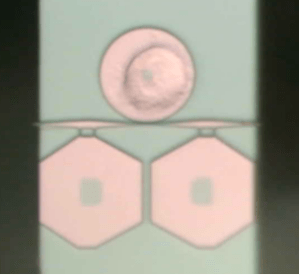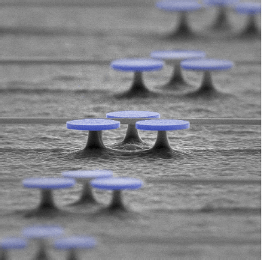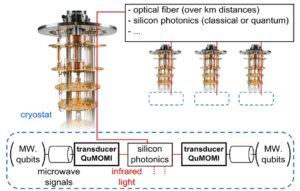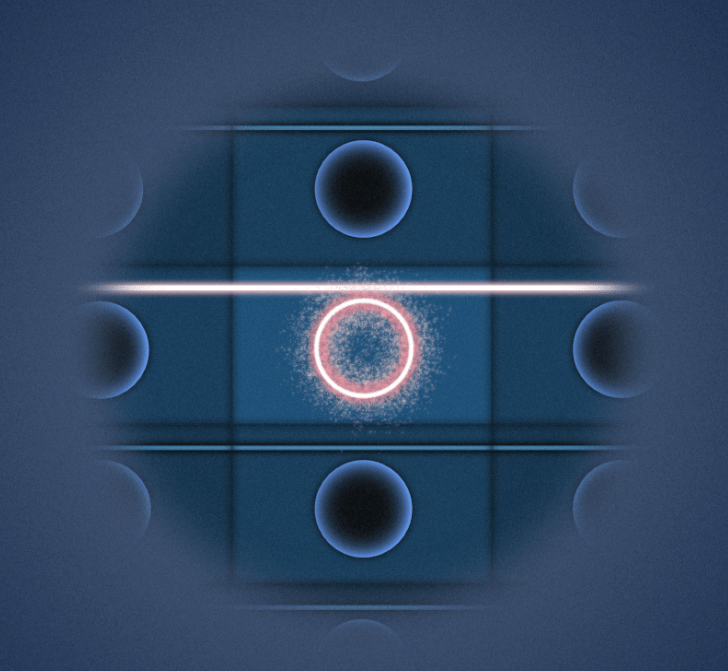Join the team
Master 2 internship / PhD offer: Optomechanical coherence of a single living cell

This internship/PhD thesis aims to explore these questions at the level of a single live cell, using the tools of quantum optomechanics, which enable unprecedented sensitivity and time-resolution [1]. In the last years, our team carried the first optomechanical experiments on biological objects, albeit in a dry environment where the biological functions were turned off [2,3]. More recently, we immersed optomechanical experiments in a physiological liquid medium in order to measure a living object in action, when biological mechanisms are this time turned on. The image shows an individual live cell deposited on the surface of an optomechanical disk (radius 11 μm) fabricated in our clean-room. The disk is evanescently coupled to a nanophotonic waveguide hold by two hexagonal pads, enabling real-time time optomechanical measurement of the cell. Building on this approach, the project will investigate active biological mechanisms in the cell and link them to the capacity to sustain or degrade the coherence of mechanical and optical degrees of freedom, hence exploring a practical interface betweem quantum science and biophysics.
Methods and techniques: Quantum optics, nanomechanics, biophysics, coherence
References:
[1] I. Favero and K. Karrai, Nat. Phot. 3, 201 (2009).
[2] E. Gil-Santos et al, Nature Nanotechnology 15 (6), 469-474 (2020).
[3] O. Alvar, et al. IEEE 36th International Conference on Micro Electro Mechanical Systems (MEMS 2023).
Contact: Ivan Favero
Master 2 internship / PhD offer (funded): Quantum entanglement of mechanical oscillators

Similarly to a single atom, the motion of a massive, mesoscopic-scale mechanical resonator can behave quantum mechanically when cooled down to ultra-low temperatures. The study of quantum states of motion of such system has both fundamental and practical interests: as a test of quantum mechanics in systems beyond the few-particle ensembles, and its interplay with gravitation; or as a light-matter interface for the development of quantum communication networks, for storing and transducing quantum information.
A mechanical resonator, such as the micrometer-sized disks fabricated in our team (picture below), also confines optical modes that strongly interact with the motion. Therefore, light provides a means to shape the quantum state of motion of such an object when prepared close to its ground state (the ‘phonon vacuum’), by adding or removing phonons one by one. Ligth also probes the obtained states.
This internship/PhD thesis aims to realize multipartite quantum control, entanglement and superposition, in systems composed of several of these optomechanical resonators, either evanescently coupled or arranged in an interferometric configuration. This work will target in particular the generation of maximally-entangled GHZ states, of importance in quantum computing protocols, or N00N states, of interest for sensing with sub-standard quantum limit sensitivity, and offering the possibility to explore the concept of nonlocal influence in quantum mechanics.
Methods and techniques: Quantum optics, nanomechanics, single-photon counting, low temperatures
References:
I. Favero and K. Karrai, Nat. Phot. 3, 201 (2009),
M. Aspelmeyer, T. Kippenberg and F. Marquardt, Rev. Mod. Phys. 86, 1391 (2014)
S. Barzanjeh, Nat. Phys. 10, 1038 (2021)
A. Barbero, S. Pautrel, …, A. Borne, I. Favero (2025).
Contacts: Adrien Borne, Ivan Favero
Postdoctoral position: Quantum states of motion of a mechanical resonator

Left: scanning electron microscope image of an optomechanical disk resonator mechanically shielded from the environment (nanofabrication by our team). Right: theoretical Wigner function of a superposition Fock state.
The motion of massive, mesoscopic-scale mechanical resonators can behave quantum mechanically when cooled down to ultra-low temperatures. The exploration of such systems in the quantum regime has interests ranging from fundamental testing of quantum mechanics in mesoscopic massive objects to their use as quantum sensors, or in quantum networks, e.g. for transducing or storing the quantum information.
This project aims at shaping arbitrary target quantum states of motion [1] of an optomechanical resonator such as the microdisk pictured on the right and developed in our group. The mechanical quantum information can be encoded in the device through its interaction with light [2], and then characterized through optical tomographic reconstruction [3]. This work will also consider increasing the dimensionality by including several optomechanical resonators, thereby involving entanglement between massive objects.
Methods and techniques: Quantum optomechanics, single-photon counting, quantum state tomography, cryogenics
References:
[1] MR Vanner, M Aspelmeyer and MS Kim, PRL 110, 010504 (2013).
[2] I Favero and K Karrai, Nat. Phot. 3, 201 (2009). M Aspelmeyer, T Kippenberg and F Marquardt, Rev. Mod. Phys. 86, 1391 (2014).
[3] MR Vanner, I Pikovski, and MS Kim, Ann. Phys. 527 (2015).
Contact: Adrien Borne
PhD project (funded), postdoctoral position: Quantum Microwave-Optics Mechanical Interface

Transducers in a quantum information network, linking microwave qubits nodes and silicon photonics
The development of quantum information technologies requires the interconnection of different quantum systems having specific tasks (processing, memory), such as microwave qubits platforms. Photons in the near-infrared allow for such efficient transfer of quantum information, preserving the non-classical state over long distances. The conversion of quantum information between microwave photons and optical photons is therefore a key step that this project aims to achieve.
The objective of this project is therefore to design a device to demonstrate the conversion of classical and then quantum signals between these two spectral domains. This on-chip converter will consist of a superconducting microwave resonator and an optical resonator, both interacting with a mechanical mode that will mediate the conversion. With these converters, we will then aim to generate entanglement between distant microwave qubits.
This project will be carried out in close collaboration with our partners in Grenoble: the Néel Institute, an expert in superconducting quantum circuits and electromechanics, and CEA Leti, one of Europe’s leading technological research organizations.
Methods and techniques: optomechanics, quantum interconnects, numerical simulations, nanofabrication, low temperatures.
Contacts: Ivan Favero, Adrien Borne
À lire aussi

TUPHO, for large-scale production of integrated photonic circuits
The TUPHO project is an initiative that aims to bridge the gap between upstream innovation and large-scale production in the integrated photonic circuits (PICs) industry. It is led by Hamidreza Neshasteh and Ivan Favero, members of the Light and Mechanics team at MPQ...

On-Chip Ferromagnetic Resonance for van der Waals Heterostructures: Anisotropy and Damping of Cobalt Interfaced with Exfoliated 2D Materials
A collaboration between the technical hub, the clean room platform and the TELEM group at MPQ laboratory has developped a new experiment demonstrating that standard broadband ferromagnetic resonance can still be effective to probe the magnetization dynamics of “thin...

Materials science – When the surface reaches deep inside…
Crystalline surfaces often exhibit reconstructions, usually assumed to affect only a few atomic layers below the surface. A collaborative study (conducted by the Matériaux et Phénomènes Quantiqueslaboratory in Paris, the Institut P’ in Poitiers, and the SixS beamline...

Exhibition – Matériaux et phénomènes illustrés
General public exhibition, free access. At the MPQ laboratory, electronic and photonic chips are designed and manufactured for use in both fundamental research and industrial applications, such as quantum telecommunications and high-precision mechanical sensors.The...
